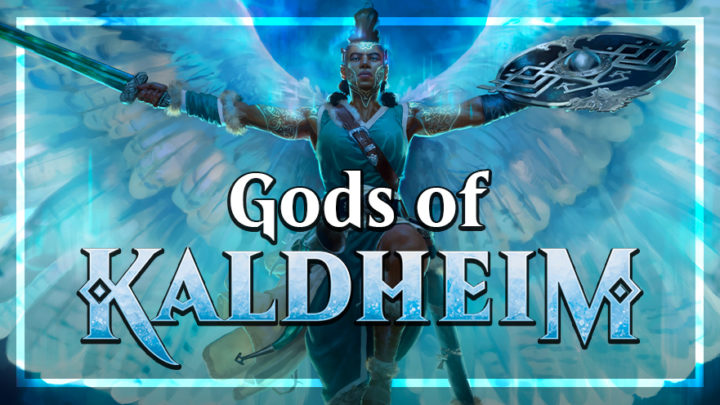Kaldheim preview season has been full of exciting new cards to brew with. Let’s review the most divine cards of the set: the Gods of Kaldheim.

The Gods of each plane have often had a unique mechanic. In Theros block, they’re indestructible and require devotion to colors. In Amonkhet, they’re indestructible and can’t attack or block until a condition is met.

The gods in Hour of Devastation go back to hand if they fall on the battlefield, and the God-eternals of War of the Spark go back into the library third from top.
In Kaldheim, we get a new flavor of God. These Gods are not indestructible, or recursive — which, if you know anything about Norse mythology, is right on the money — but instead feature a flipside. MDFC Gods are Kaldheim’s take, and on their reverse is something associated with the particular God, whether that be a creature, an enchantment, or even a vehicle.
Alrund, God of the Cosmos
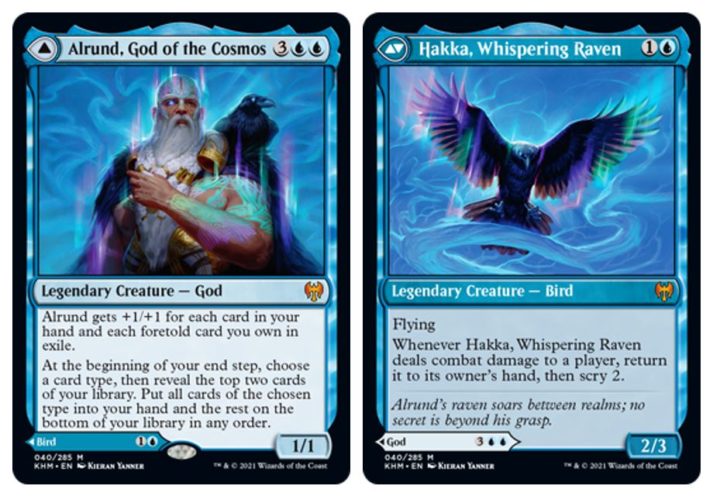
Alrund, God of the Cosmos is quite obviously our analogy to Odin, the Allfather, oldest and highest of the gods of Norse mythology. Odin was father to many of the Norse gods, and there are parallels with Odin in the artwork, too, such as his having only one eye — the other having been given up to Mimir.
Alrund, being Kaldheim’s parallel, is a powerful Magic card. On his front side, his power and toughness get a boost equal to the card you have in hand and each foretold card you own in exile. In a dedicated Foretell deck in Standard, this means your hand size depleting doesn’t actually matter until you cast those spells. On average, I see Alrund being a 5/5 most of the time.
On the flipside, Hakka is a two-mana 2/3 flyer that scrys 2 when it connects. The goal of MDFC Gods is to give them a use when you have multiple legendaries in hand, and this is a really great piece of design. Hakka is definitely useful, especially given it can set up our end step draw ability.
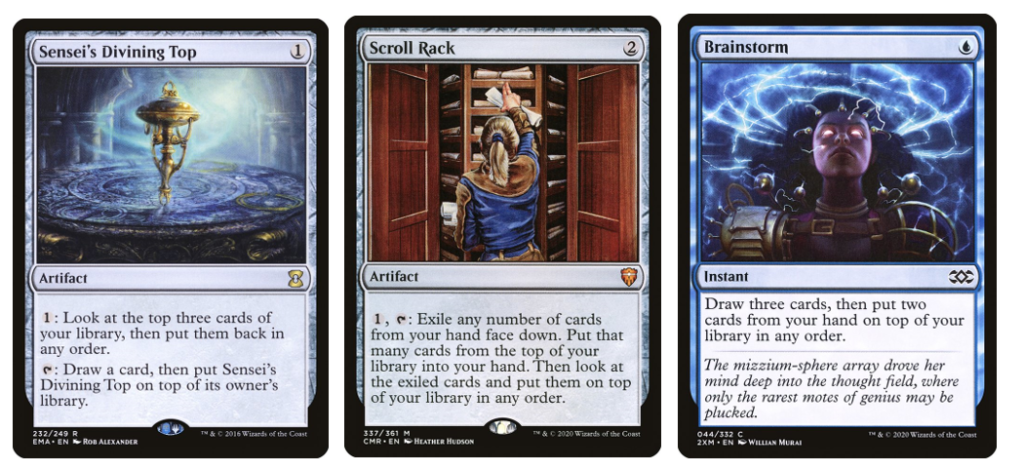
His other ability lets you put up to two cards into your hand at the beginning of the end step. It’s a powerful ability, and one that can be set up to ensure the best chance of drawing two cards. In EDH, think Sensei’s Divining Top, Scroll Rack, and the many cards that let you scry as part of spell resolution. Heck, with Brainstorm, you could just be drawing three cards if you put the right two back!

I can see Alrund being a flavorful Commander in his own right, but where he’ll truly shine is in an Eligeth, Crossroads Augur deck. In a deck that cares so much about scrying and drawing cards already, Alrund is always going to be big, and you’ll easily be able to set up to draw the maximum number of cards at the end of the turn.
Birgi, God of Storytelling

Birgi seems to be a God that draws from many wells of inspiration. Part Freyja, the “party” god of the aesir, with clear links to Bragi, the poet/bard god, which is etymologically close to bragging, or in Kaldheim: boasting.
Harnfel, Horn of Abundance is a five-mana card filtering engine. For zero mana investment, you can discard a card in order to impulse draw — the act of exiling the top card of your library to play this (or until the end of your next) turn. It’s alright, but it’s gravy on an otherwise great card.
Birgi is a great example of red’s “fixed” place in the color pie. Adding red each time you cast a spell and not having that mana leave your mana pool as steps and phases end is sweet, and can lead to some really stormy lines of play. Birgi’s second ability lets you boast an additional time per turn, which can let you use that mana effectively.

Being able to see more cards with Tuskeri Firewalker before casting them to add more red mana seems sweet, but it’s in her ability to enable multi-spell turns that the real quality lies. Grinning Ignus gives you an infinite storm count on its own, and in many ways she feels like Runaway Steam-Kin. I expect her to sit at the heart of many a combo in Commander, and do a lot of work in the right Standard aggro deck.
Cosima, God of the Voyage
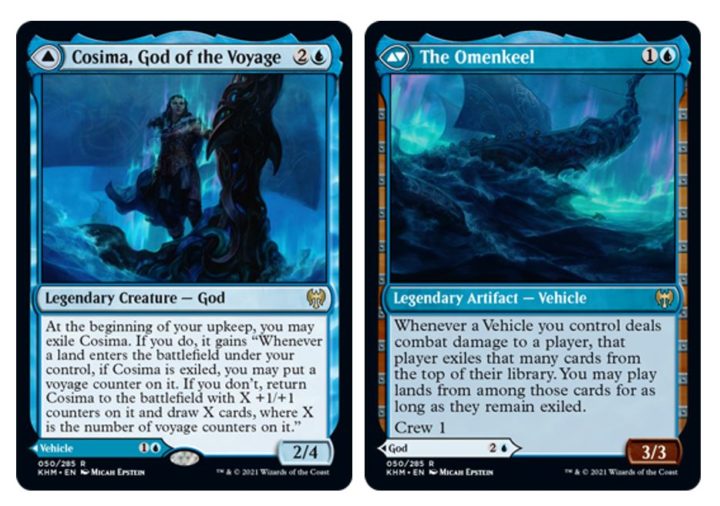
Cosima, God of the Voyage seems a mix of both Njörðr, the old Norse god of the sea, and Rán, the Norse goddess of the sea. Her boat, The Omenkeel, is said to be able to carry travelers between the ten realms of Kaldheim.
On the front, Cosima is a little hard to parse, but essentially, she works like so: at the beginning of your upkeep, you exile Cosima. While she is in exile, each landfall trigger allows you to either put a voyage counter on her, or bring her back from exile.
When she does come back, she draws you cards and has +1/+1 counters equal to the number of voyage counters she accrued. She can stay away for as long as you like, and as far as top-down design goes? It’s elegant and something I can really get on board with.
Now, obviously, hitting land drops is important with Cosima. Thankfully, her flipside, The Omenkeel, helps out with that. When any vehicle deals combat damage to a player, you exile that many cards from the top of their library, and can play any land cards among those cards for as long as they remain exiled.
In Standard, I can see this functioning along the lines of a “fixed” Smuggler’s Copter — the stats are the same, with the condition being it will always draw you lands. I imagine at this rate, with a playable flipside, it will see some amount of play.

In Commander, this card asks that you make extra land drops as often as possible to hasten Cosima’s return. Aside from my advice to run at least thirty-eight lands — because hitting land drops is important! — I would say you need to concentrate on the few ways of ramping mono-blue has access to. Think Sword of the Animist, Dreamscape Artist, and Walking Atlas.
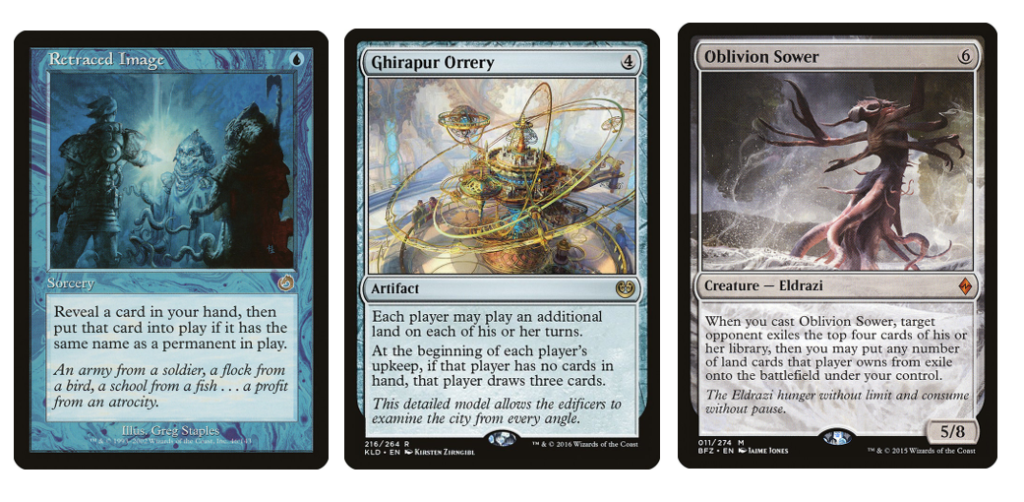
Thinking outside the box a little, Ghirapur Orrery is a shoe-in and Retraced Image is a blue ramp card that most people are still sleeping on. The big one to pick up for me, though, is Oblivion Sower. What you might not realize with this one is that it lets you put any number of land cards an opponent owns in exile into play with its trigger. That means that if you’ve previously exiled lands with The Omenkeel? Well, you can drop all of them into play.
Egon, God of Death

Egon is Kaldheim’s God of Death. Though really quite old, Egon apparently ages backwards! In Norse mythology, Egon is probably closest to Hel, the goddess who rules over the underworld, a daughter of Loki. They both share a grim and mean disposition.
At just three mana, Egon is a very good rate for a 6/6 with deathtouch; those stats usually require six mana. The inevitable downside is that you must exile two cards from your graveyard each upkeep to keep Egon in play. At least if you can’t, you can draw a card when you sacrifice him — which will fuel another Egon drop.
Like most of the Gods, Egon’s other side synergizes well with the front face. The Throne of Death mills a card each upkeep, and can also draw cards on its own. For a measly one mana, it’s a pretty good enabler.
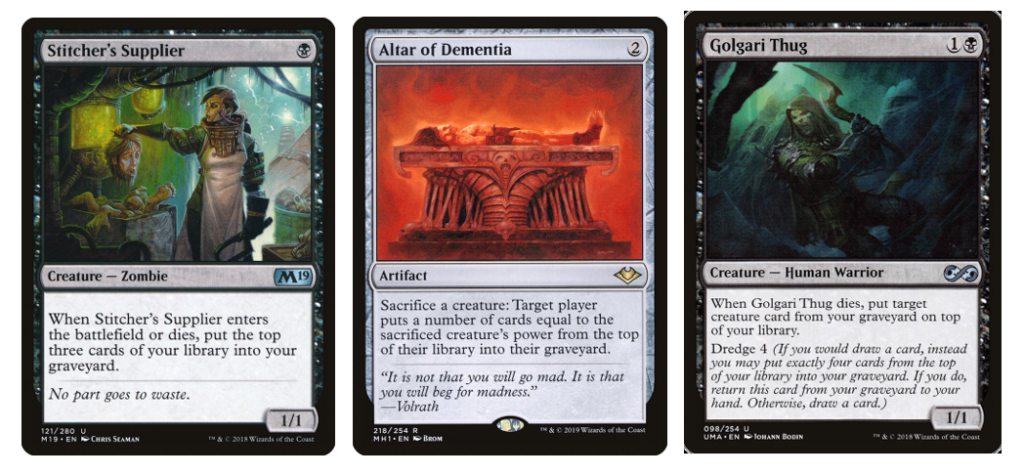
Getting this going shouldn’t be too much of an issue in EDH. Any deck that cares about self-mill will have plenty of options for getting cards into the graveyard, with Sultai-based dredge decks able to capitalize most readily.
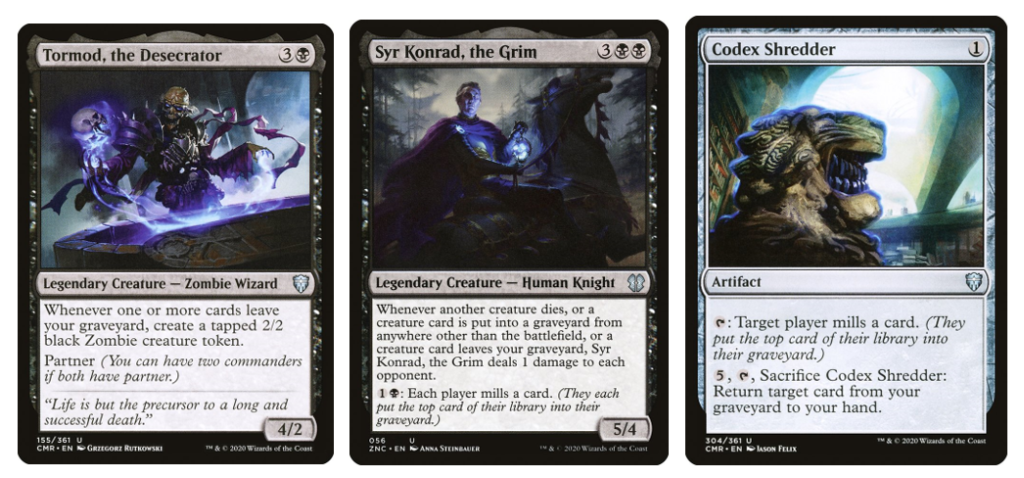
If you want to build around Egon in mono-black, then there are more than enough payoffs, too. Tormod gives you zombies, Syr Konrad can ping for damage — and set up combos — and you get all of the best ways to fill and recur from your graveyard.
Esika, God of the Tree
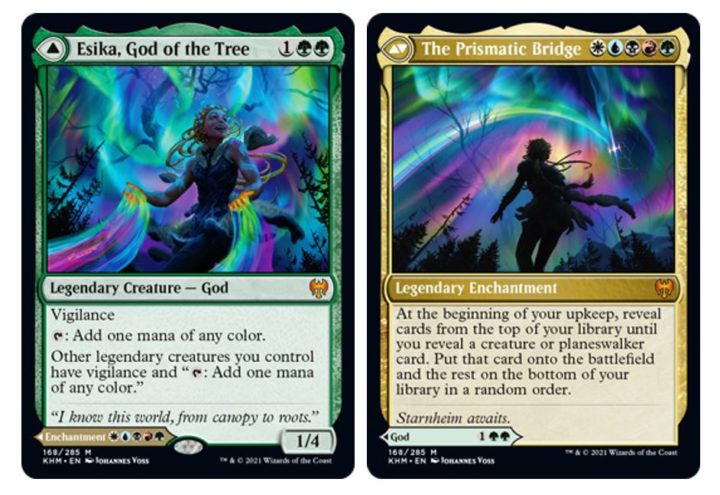
Esika is based on Idunn, sometimes called Iduna. Idunn is the Norse goddess of Spring, and keeper of magic apples that the Gods consumed for their immortality. In Kaldheim, Esika decocts an elixir from the sap of the World Tree for the same ends.
Esika is a three-mana mana dork that grants your other legendary creatures vigilance and the ability to also tap for any color of mana. While the front side is pretty nice, it’s the back half of this MDFC that has people excited.
The Prismatic Bridge is a five-color enchantment that lets you reveal cards from your library until you reveal a creature or planeswalker and put it into play — every upkeep. It’s a seriously powerful enchantment, and it’s probably a good job it’s legendary. Of course, this card is analogous to the Bifröst — even if your exposure to Norse mythology is as shallow as Thor: Ragnarok, you’ll be able to make the connection.
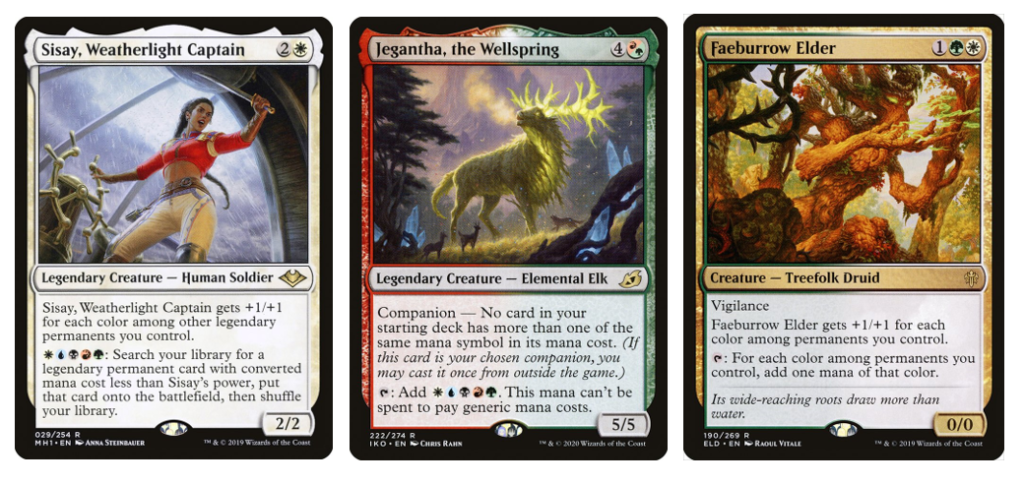
A potential win condition in Standard — if a little hard to set up — Esika will shine in Commander. She obviously slots into Sisay, Weatherlight Captain with ease, giving the deck more mana production and more card advantage. On her own, I can see a five-color polymorph control deck emerging.
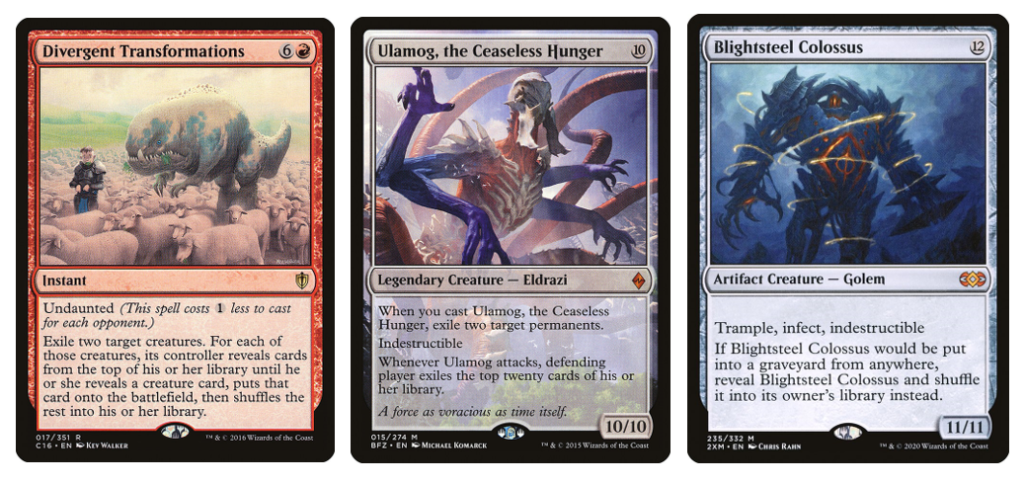
With the ability to cascade into a huge threat if you can untap, there’s no reason to pad out your deck with smaller utility creatures. There’s more than enough good control when you have access to all five colors — Niv-Mizzet Reborn can attest to that. Esika is a card I’m excited to see hit tables.
Halvar, God of Battle

Halvar is the God of Battle, and though Odin is, among many things, seen as the God of War, Halvar most closely parallels Týr, the Norse God who presides over the more honorable aspects of battle, like justice and laws.
Halvar and his flipside, the Sword of the Realms, are a build-your-own-recursive-threat package. Halvar can auto-equip the Sword of the Realms at the beginning of combat, and thanks to his other ability, he will gain double strike on top of the +2/+0 buff from the Sword. A 6/4 double striker is a potent threat, especially when it can bounce back to hand upon death with the Sword of the Realms’ other ability.

Though maybe a touch too much mana for an aggressive white deck to muster in Standard, Halvar can do a lot of work in Commander in equipment decks. The three most useful recent additions to equipment decks in EDH — Ardenn, Koll and Reyav — all share Halvar’s abilities between them, and redundancy is the key to any strong strategy.
If you’re brewing an equipment deck, why not check out my articles on Akiri, Fearless Voyager, Syr Gwyn, Hero of Ashvale, and Koll, the Forgemaster?
Jorn, God of Winter
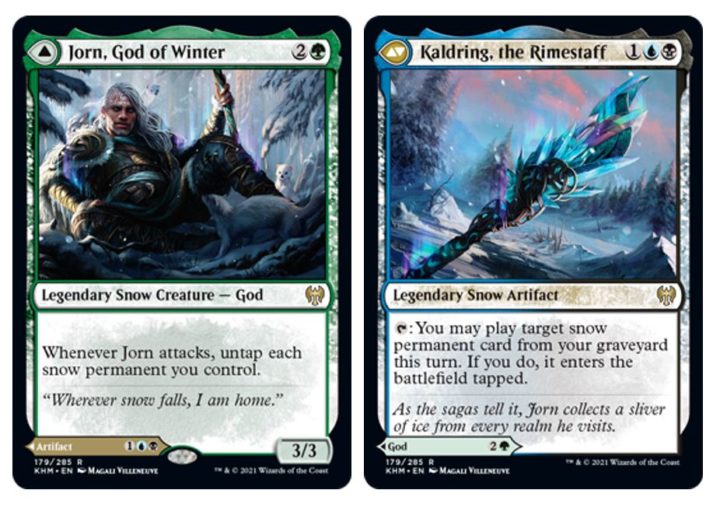
Jorn, like Cosima, is based on a gender-swapped Norse deity. Skaði — or Skadi — is a jötunn and goddess associated with hunting and winter, and likely to be the inspiration for Jorn.

Jorn, meanwhile, is a Sultai player’s dream. Whenever he attacks, you are able to untap each snow permanent you control. Note that says “permanent” — so that includes your lands!

On the front side, Jorn is the best part of Sword of Feast and Famine. On the back? He takes some inspiration from Muldrotha, the Gravetide. Though the permanent will come into play tapped, having recursion on the flipside is still really powerful. Even without a deck full of snow permanents, just playing the best ones and untapping your lands is still more than enough.
Kolvori, God of Kinship
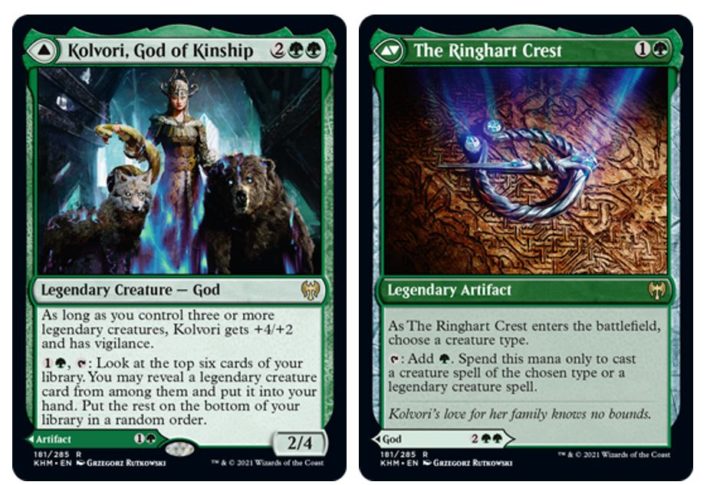
Kolvori, God of Kinship, has no strong connection to any Nordic god or goddess in particular, and is likely a pastiche of many gods and themes — if you know of inspiration, let me know.
Kolvori, like Esika, cares about legendary creatures. She can dig six cards deep for them, and gets a reasonable buff when you have enough of them in play. On the flipside, she’s a mana rock for legendary creatures or creatures of a type chosen as The Ringhart Crest enters play.

Of the Gods, she feels the least exciting, with universal application but in a generic kind of way. She’ll help cast four-mana commanders that care about Legendary typing, like Captain Sisay, and she can slot well into a deck like Yeva that wants to keep topped up on cards.
Reidane, God of the Worthy

Reidane is probably based on Sól, the Norse god of the Sun. The Sun god has long been associated with justice and righteous action, and what’s more, there is a shield in Sól’s chariot to protect the realm below from the sheer fiery power of the Sun.
Reidane is costed pretty efficiently. At three mana, a 2/3 vigilant flyer is a good rate, and her ability is pretty strong. Making board wipes cost more mana is a way that white can gain card advantage and keep its board, and whether that’s in constructed or in Commander, it’s a valuable ability.
Making snow lands enter tapped is nice, but I’m unsure if it’s enough to curb snow lands in formats like Modern on a card that dies to most removal, and with mana bases as flexible as they are. Jim Davis has a good take on this.
Having Valkmira, Protector’s Shield in the Command Zone is an exciting prospect, though, and it’s still a pretty great resource in the ninety-nine.
Tergrid, God of Fright
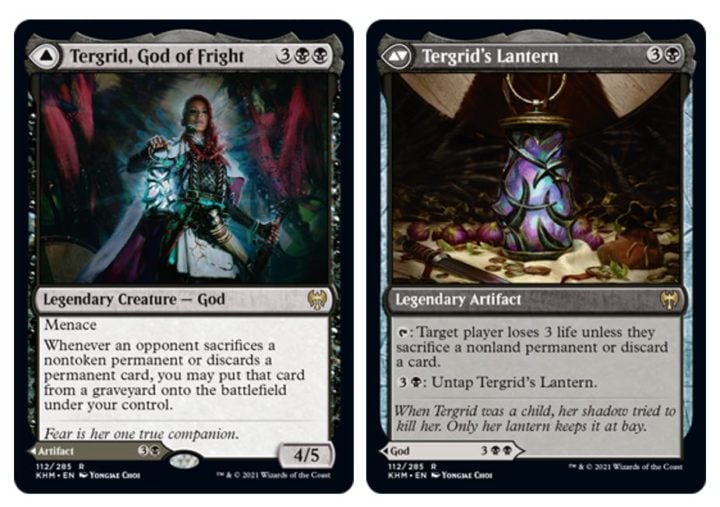
Tergrid is the God of Fright, and if I had to pick her inspiration, I’d probably say it was equal parts Odin — who had the ability to influence the minds and composure of men in battle — and Nótt, a goddess of dreams and the night.
Tergrid is a frightful God to behold, and one many players will either be itching to build, or itching at the thought of sitting across from. It just so happens that the most synergistic cards for Tergrid are also the most unfun.

Though she’s a little pricey to play alongside Thoughtseize in Historic, Commander synergies are abundant. There are ways to make everyone discard, like Awaken the Erstwhile; ways to cash in on triggers, like with Rankle; and ways to keep cards flowing into the bin, like Dark Deal.

She’s a shoe-in for Grave Pact strategies, too, and makes Grave Betrayal look pretty expensive. It’s a redundant piece worth running, though.
Toralf, God of Fury
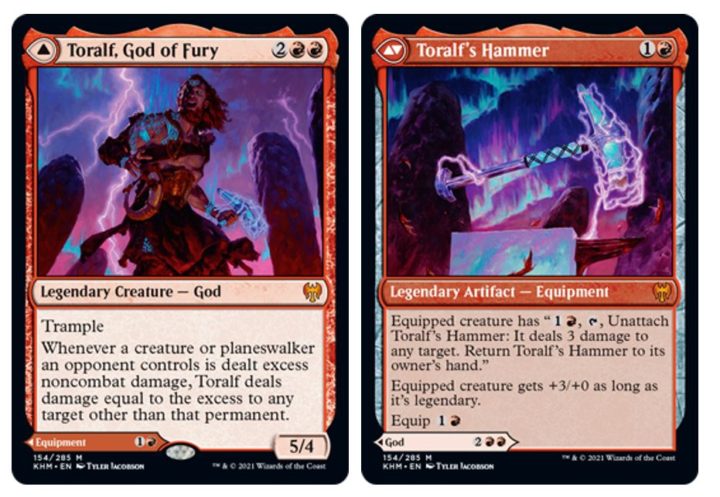
Toralf and his Hammer are quite obviously Thor and his hammer Mjölnir. Both Gods share associations with thunder, fury, and martial prowess.
Toralf is a 5/4 with trample for four, which is already a good rate. His ability turns any excess damage (except for combat damage) dealt to creatures or planeswalkers opponents control into damage to any target other than that permanent.

What this means is that basically any burn spell that would do more damage than necessary to kill a creature now converts that damage into direct burn, which is incredibly efficient. While commanders like Neheb, the Eternal have long been mainstays of burn decks in Commander, Toralf looks to be shaping up as a contender for the title.

Toralf’s Hammer is a throwback to Cube and Limited star Hammer of Bogardan, and ends up being cheaper to replay with the ability to activate at instant speed, reminiscent of Sunforger. To take full advantage of the +3/+0 buff, putting this on a creature with vigilance is a good plan.

To get the most out of Toralf, making him indestructible is a good start, as recasting him will get pretty expensive. You can also do some pretty funny things with Brash Taunter. By aiming the damage from Toralf at Brash Taunter with a damage doubling effect in play, you can magnify the damage an extra time before unleashing it to face. I can’t wait to try this out.
Valki, God of Lies
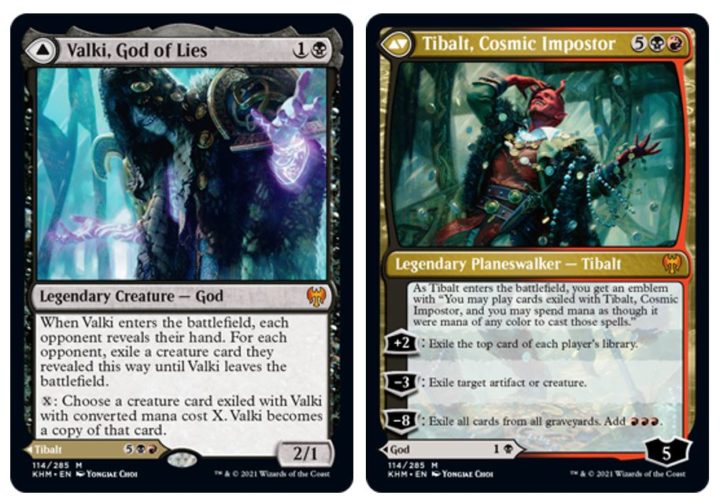
Last, but certainly not least, is Valki, God of Lies. While Valki may be based on Loki, the trickster God, he’s everyone’s favorite infamous planeswalker Tibalt in disguise. A trickster indeed.

Valki is reminiscent of hand disruption effects like Kitesail Freebooter, but with an added upside: you can pay mana to become a copy of the creature exiled with the effect. This is reminiscent of Dimir creatures like Lazav, the Multifarious.
On the other side, Tibalt, Cosmic Impostor is a seven-mana planeswalker. Let me get it out of the way right now — you won’t be casting Tibalt from the Command Zone much at all, even with Cabal Coffers.

Where this card gets interesting is in Modern or Legacy. Thanks to how MDFC cards with spells on each side work, you can cascade into one and cast either side.
This means that if you cast Shardless Agent or Bloodbraid Elf and cascade into Valki, God of Lies, you’ll be able to cast the card as Tibalt, Cosmic Impostor. A five-loyalty planeswalker that ticks up to seven when it comes down on turn three or four is a big threat, particularly as it can protect itself with a relevant downtick. Yeesh!
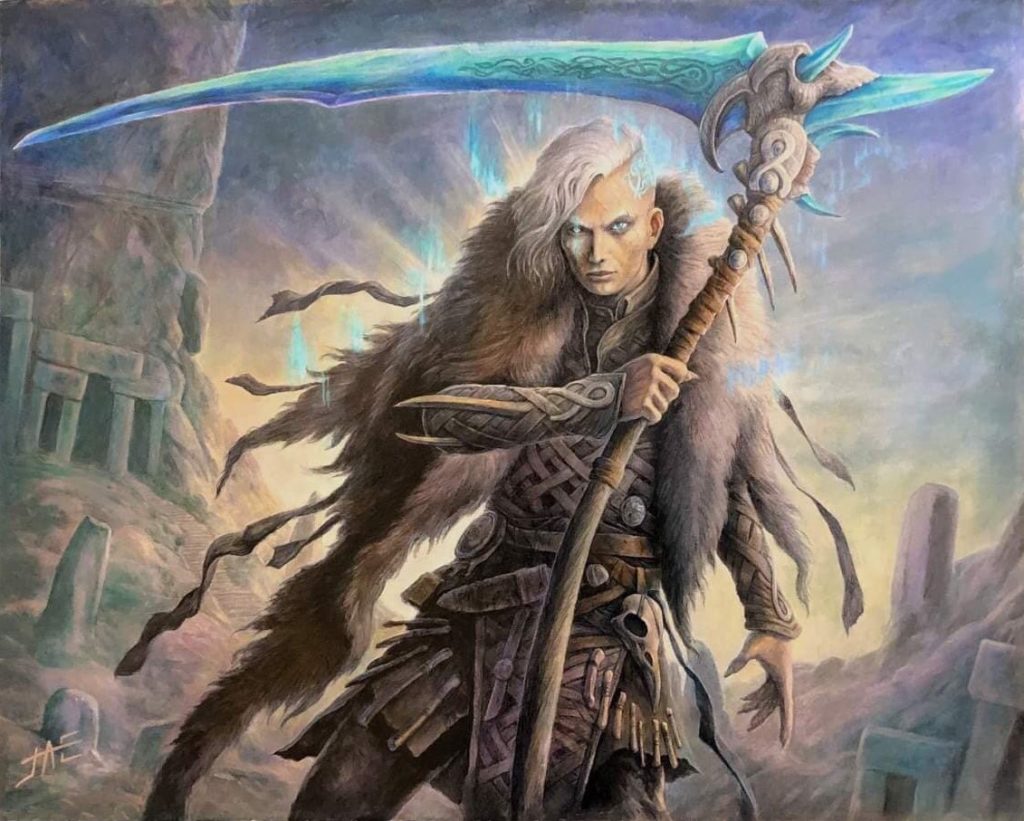
Ragnarok
Like all good things, this article had to come to an end sometime. I hope I’ve covered all bases with the Gods of Kaldheim for you today — I know I’m excited to see what these cards can do!
If you’re looking for some extra reading on Kaldheim and Norse Mythology, particularly when it comes to modern day Heathenry, check out this excellent article from Jacob over at Hipsters of the Coast.
Once again, if you enjoyed this article today, let me know on Twitter. I’d love to hear what you’re planning to do with the Gods of Kaldheim. How are you planning to build with them?

Kristen is Card Kingdom’s Head Writer and a member of the Commander Format Panel. Formerly a competitive Pokémon TCG grinder, she has been playing Magic since Shadows Over Innistrad, which in her opinion, was a great set to start with. When she’s not taking names with Equipment and Aggro strategies in Commander, she loves to play any form of Limited.

